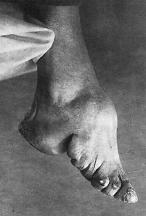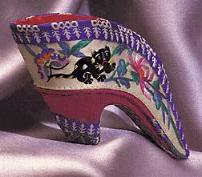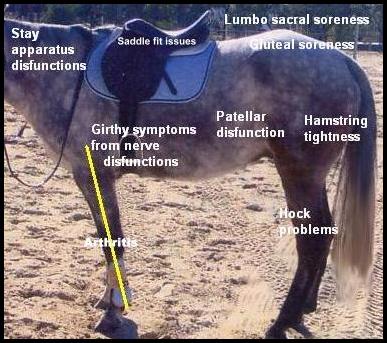
Postural clues that identify sore hooves.
By Chrisann Ware, Equine Myofunctional Therapist
Equethy Equine Educational Workshops (Aust.)
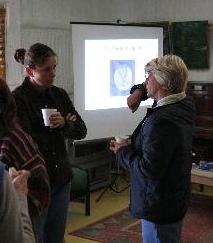 |
As an Equine Myofunctional Therapist dealing daily with equine musculo-skeletal problems in my clients horses and through the hundreds of Equethy workshops I have had the pleasure to meet many horse owners who sought barefoot rehabilitation. The comment I hear all the time after they begin to become aware of the unusual postures that their horses are adopting is “ I wish I had known the relationship between posture and sore hooves earlier.... I could have helped my horse years ago instead of wasting all that time while he was getting steadily worse." I tell them don't feel that way because you cannot change the past but you can indeed change your horse's future by fixing his feet now.
|
Firstly let me say one thing; Horse shoes slowly deform horses’ hooves . This is now proven science.This is not even up for debate now as there have been coutless thousands of documented cases that are a testament to the huge difference in hoof health to be gained by a barefoot lifestyle and thousands more documented cases now showing the rehabilitation of serious hoof conditions such as navicular syndrome. We are now just waiting for the training of our hoof care professionals to catch up with the work being done at the coal face! The effects of steel horse shoes.They also alter the very integrity of the structures inside the hoof that were engineered by nature to withstand the huge weight of this large animal in motion.
Don’t think it’s possible? Just look at our own human history and the practice of foot binding during the Tsang Dynasty. “Well, horses are different” I hear you say. Actually the way living tissue and bone reacts to years of unnatural stresses is not as different as you may think. (refer Wolfes Law of Orthopaedics). |
|
Why does caudal heel pain develop in the (back) hoof area first?
Because this is where all the soft tissue structures lay inside the hoof capsule that were designed to act like our heels do and take the brunt of the stride landing. These amazing structures fill the back half of the hoof with the pedal bone P3 sitting ahead of them at the toe.
So...depending on the breed, the age of first shoeing and the abilities of those shoeing the horse thereafter to balance the hooves, the deformation can happen very quickly, or slowly over many years, but it will happen. Hoof distortion causes caudal heel pain and avoiding this is often the first symptom that owners really notice. A slight lack of impulsion, then unwillingness to land a jump or the horse will try to traverse downhill slopes in a creeping way. Eventually the horse will display vague lameness or short stepping.
The hoof will deform by either running forward and becoming splayed and flat, or start to contract at the heels and become steeper. The type of deformation usually depends on the hoof shape particular to that breed.
Below are extreme examples of this. Thoroughbreds & breeds with wider pedal bones tend to acquire under run, long low heels and forward over long toes, and breeds with more conical hooves such as ponies and Arabians tend to deform to become more contracted and steep. Many horses thought to have navicular syndrome actually have acquired caudal hoof pain stemming from their deformed hooves. Every single case of navicular syndrome displays some degree of hoof deformation! Every single one! It is never seen in physiologically correct hooves! Read that again........its really important!
 |
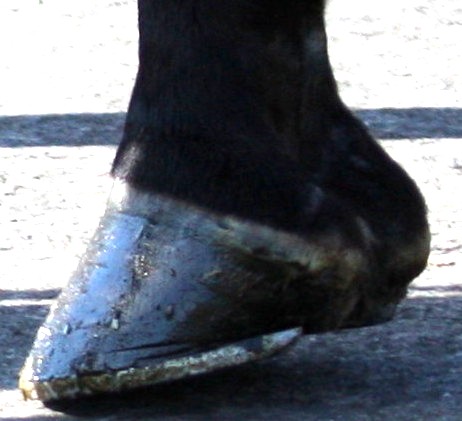 |
Why do the front feet begin to deform first usually before the back feet become involved?
I believe it’s because of the unique role they play in the bio-mechanics of the horse which involves a lot of breaking and impulsion in an upwards direction. The hind hooves seem to stay in a better shape for longer, due to their very different role in locomotion which is more about digging in and driving the horse forwards.
If you don’t know a thing about good hoof form and your horse isn’t limping lame how can you know if the horses are sore?
Easy..... just look at the way they choose to stand! Posture is a dead giveaway!
If you have a sore foot yourself and you walk ,and stand, always avoiding the sore area, after a time you will find you have secondary problems such as a sore back or sore hip.
Continue to adjust your posture for many years and eventually this will even lead to changes in areas as remote from your injury and as unbelievable as your eyesight because you will eventually carry your head tilted, to offset the tilted shoulder that is compensating for the tilted hip which is allowing you to take weight off your sore foot.
A checkerboard of problems will arise throughout your body. The same thing happens to horses who adjust their bodies to avoid years of heel pain.
To identify horses with hoof pain it is first necessary to identify what is the natural comfortable stance for horses.
We live in a world of sore horses and most of us have come to accept their various abnormal postures as normal. We need to look again armed with some knowledge of why they are choosing to stand as they do.
Sadly over the years many of the warning signs of hoof pain have been mistaken for conformational problems and even written about as such in well known equine texts.
Horses are said to be “over at the knees” when in fact they have no knee problems at all and their strange stance stems just from caudal hoof pain. Others have been said to have overly sloping pasterns when they are merely “forced” to have these due to abnormal P3 (pedal bone) alignments within the deformed hoof capsule. This forces abnormal angles on the pasterns as the horse compensates.
No amount of corrective shoeing, remedial body work or chiropractic work will relieve upper body problems caused by constant postural adjustments due to hoof pain. It is the single greatest cause of musculo-skeletal issues in the domestic horse.
Normal Posture: Whether a young foal or an old horse they should be able to utilize fully their “stay apparatus” muscles of his forehand and partial stay apparatus of his hindquarters. To do so they must be able to keep their front legs vertical as illustrated below.
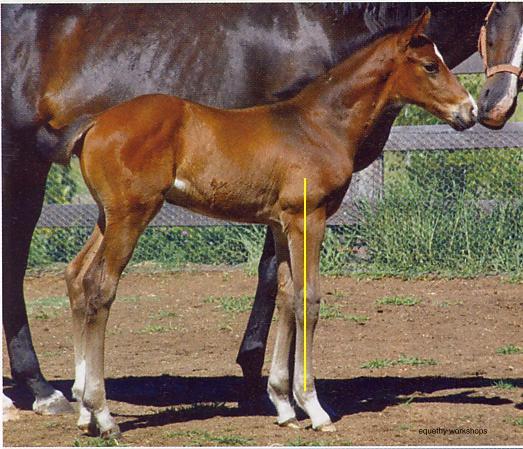 |
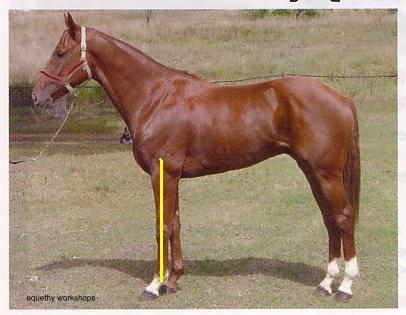 |
A comfortable stance is shown on both these horses fully engaging their front leg stay apparatus with forelegs locked vertically.
Notice the good definition of the musculature in the older horses neck & shoulders; the deep indent in front of the scapular (shoulder blade) in front of the withers. These forehand muscles are as they should be. Soft and flexible and normal size.
How to identify caudal hoof pain: Simple! Sore horses lean forwards to unweight their sore heels .
Most of us are familiar with identifying limping lameness but what is so insidious about hoof deformation from shoeing is that it is slow to develop, and the horses don’t technically limp as pain develops equally in both front feet! So these horses can’t limp in the clinical sense but they will lean forward.
Even if you don’t know a single thing about the hoof except where it fits on the leg you can clearly see horses who adopt this forward posture. It’s a huge warning light. If you see it in your shod horses they are already very sore.
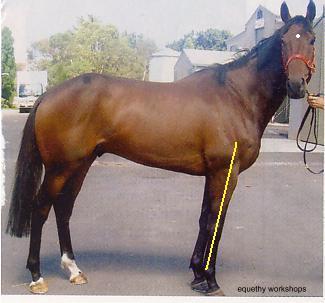 |
The chest is clearly be seen to be held forward ahead of the legs to take the weight off the caudal hoof (heel area).
At first these postures are subtle, but as the hoof deformation and associated pain progresses so does the advanced forward leaning stance.
The sore horse now adopts altered gaits as well. Riders may notice they are less forward going, less keen to stretch out. They are clumsy and begin to trip, dressage riders find their horses begin to loose impulsion, show jumpers find they will start to run out on jumps or buck on landing, trail riders find their horses unwilling to travel downhill and tend want to creep down slowly or try to go down sideways.
Beware – the toe first landing - also a warning sign. These sore horses will now try to do toe first landings with every stride instead of the correct heel first landings nature intended.
How can you tell? If you look closely at a horse with caudal heel pain land a stride, you will see a little spray of dirt shoot out ahead of the toe as the horse lands toe first. If you can video it you won't miss it! These toe first landings cause the tripping and stumbling when the toes dig in and butt against something solid in the ground surface.
These horses may also buckle at the knees occassionally due to contracted and weakened foreleg musculature. Its not easy to maintain these postures and it takes a toll on the stay apparatus muscles.
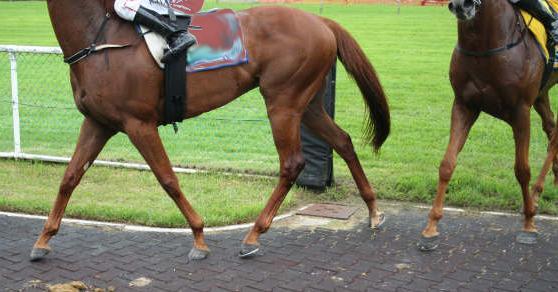
Many racing thoroughbreds like the fellows at right, suffer early onset hoof deformation due to the practice of very early shoeing so common in that industry. They are often shod when their hooves are barely past foal age. The bones of a horse, no matter what the breed do not mature till the horse is at least five years of age, this includes the bones of the hoof, some bones in the spine even later when they are nearly six. So shoeing horses as yearlings puts them on a fast track to hoof problems.
This early shoeing in the race industry has implications for both horse and rider as tripping and falling is not something that you would like to have happen to valuable horses who work at speed and carry a human life atop them. Hoof imbalances also cause horses to over reach and become unco-ordinated so these young horses often knock themselves bout and rip off their shoes when put into work.
Another sinister consequence of toe first landings is the snapping effect that it causes to the tendons. This “whip lash” effect occurs as the horse drops its weight onto the hoof after a toe first landing. In sore horses this tends to be a quick, uncontrolled and badlyco-ordinated drop after a toe first landing. Done without the dampening of concussion or the slow controlled yeilding to weight bearing that should normally happen, it ill cause continual micro-traumas to the centre of the tendon. This cumulative damage often leads to serious tendon tears.
Note the very evident toe first landings (front and rear) on these three year olds!
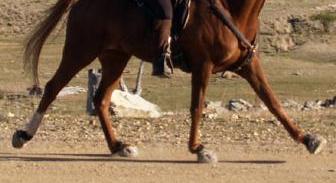
In comparison the picture above of Carol Layton’s highly successful booted endurance horse clearly show great heel first landings. He is working in harmony with his biomechanics. Most of the concussive shock is being absorbed in the caudal hoof and dissipated at ground level which will lead to less injuries during his performance career. Amazingly long distance riders often notice that they also suffer less knee pain when they ride barefoot & booted horses!
Adopting a continual forward lean has horrendous consequences for the musculo-skeletal system. Firstly it creates dysfunctions in the “stay apparatus” muscles of the forehand. Later their entire musculature becomes involved from one end of the horse to the other with secondary compensations.
The “stay apparatus” in the forehand works to lock the leg straight, from shoulder to pedal bone by exerting equal and opposite forces down through a system of muscles and tendons. This lock allows the horse to sleep and rest in a standing position. Not just something nice for horses to do, but an evolutionary necessity to avoid fatigue for an animal that lives most of the time on its feet.
When the horse has physiologically correct hoof form they hold the leg effortlessly in this lock, with practically no muscular effort; but the foreleg MUST be vertical for this system to work efficiently. A forward leaning posture makes it impossible for the horse to have a vertically straight front leg.
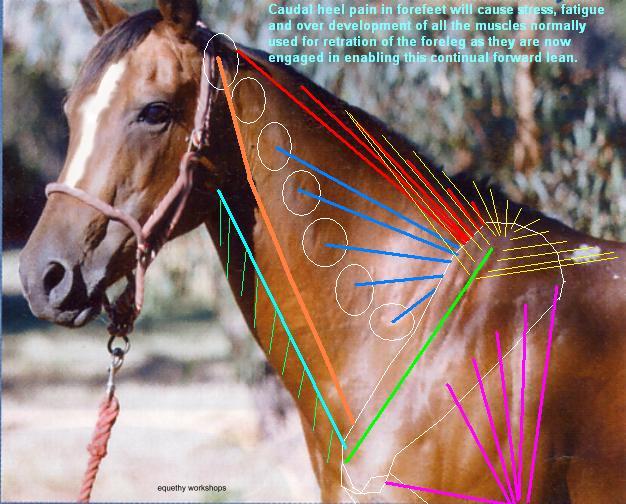 |
Leaning interferes with this mechanism and horses that cannot “lock” their foreleg stay apparatus to rest must use other muscle groups in the forehand to assist in keeping the forelegs straight. These extra muscles would normally be involved in locomotion, and taking on a continual support role causes them to over-develop, become fibrotic, contracted and fatigued. Many horses are undergoing continual body therapies and chiropractic manipulations for problems that will only return again and again as the source of theses problems remains undiscovered and unchanged.... the deformed painful hooves. Notice the over development of muscle groups in the shoulder and neck of this horse at left. He has no indentation in front of his scapular and has developed a thick and blocky neck. This is muscular overdevelopment from postural adjustments. Many equine body therapists are not yet trained to identify hoof deformation so unless they have developed an interest in barefoot rehab, to them, if the hooves look tidy and well shod and the horse is not limping lame they won’t suspect hoof pain as the source of muscular hypertrophy. To anyone working on the equine even natural therapists, I cannot stress how important learning about natural hoof care can be. It opened up an entire new world of healing for me. If you are working on horses and don’t have this knowledge you have become part of the problem instead of part of the solution. As the years pass and the hooves deform further, the caudal heel pain increases. Muscles of the shoulders and upper legs now may become so fatigued and stressed from trying to maintain this lean that some horses actually adopt a slightly bent knee stance to gain some relief. |
By now it’s obvious to their owners that they have a serious problem and veterinary attention is sought. Usually the hoof deformation is not considered as the source because as yet many vets have not been exposed to barefoot rehab and don't recognise how truly deformed most shod hooves are.
The old solution for these problems was expensive and invasive salvage surgeries to cut ligaments or destroy nerves. After these surgeries the horse was put on a regime of corrective shoeing and pain medication for life. I believe this is merely palliative care. More of the very thing that caused the problems while the hoof deformation continues unchecked causing bone loss and bone deformities within the hoof capsule. By now these changes are clearly obvious on x-rays and so are thought to be the cause of the lameness when they are actually secondary and due to the advanced hoof deformation.
If this radical course of action has been suggested to you by your vet you might like to contact a veterinarian who deals in natural hoof care rehabilitation and seek a second opinion. I have not yet seen any case of navicular syndrome that has not dramatically improved with the use of natural hoof care and hoof boots. Many have become sound riding horses again and returned to their performance work.
What are REVERSED ANGLES? One of the most common and least understood hoof/body/biomechanical probems in the world!
Secondary hind quarter muscle problems from hoof pain – “Reversed Angles” : This is probably the most misdiagnosed issue in equine physiotherapy!
As time goes on and the horse struggles to overcome a litany of problems he develops a checkerboard pattern of compensation throughout his body. Next hind quarter problems appear and lumbo-sacral pain and hamstring stiffness develop. This is due to the horse now shifting greater amounts of weight onto their hindquarters.
With this constant transference of weight to the hind quarter the hind hooves become involved in the deformation process too, low heels. Often the natural angles that the pedal bone sits within the hoof capsule on hind and forefeet become “reversed”. This interferes with natural equine biomechanics.
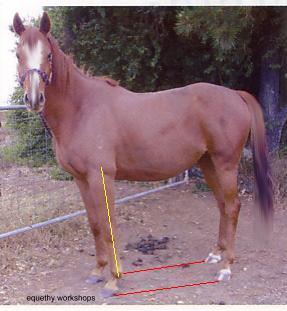 |
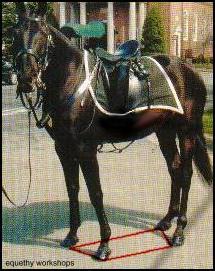 |
Professional Barefoot Trimmers know this “all hoof involvement” and circus elephant stance as Reversed Angles which is what it actually is. Once this stance is clearly visible the horse has many serious musculo-skeletal issues to contend with.
It may also be called the “ Box Stance” because the horse's posture appears as if he is standing on a small box like a circus elephant.
Often the gluteals located in the rump become so stressed and tight from maintaining this posture that they appear like little pillows bulging up on both sides of the rump, even on thin horses.
What is happening?
It is easy to understand if you think about it. If the farrier is shoeing to match the increasing hoof deformit, then as the heels will just continue to crush and become lower. The steel shoe prevents any wear or natural correction from happening. Shod like this its just geometry! As the hind heels get lower the horse is forced to bring his hind hooves further and further underneath him and so places more and more weight on his hind heels.
If you see horses with shoes with trailers these are supposed to move more weight back to where it should be...........this is impossible and they will just speed up the collapse of the heel area.
To the horse it feels like living in snow skiis would to us, and puts abnormal torque on the hock and stifle joints which often become problematic due to this.
Corrective shoeing? It will probably the first thing your vet will recommend if he/she has not become aware of the latest rehab techniques. It is the LAST THING your horse needs. You cannot fix the problem with the very thing that caused it. Even if you call it "corrective"!!!
The pedal bone (P3) of the forefeet, and hind feet have evolved to be slightly different in their shapes and the angle on their anterior surface is also slightly different. This is because the hind and fore hooves play different roles in the equine biomechanics and need to be slightly different in their shape and angle. The forefeet are basically used for braking and impulsion in an upward direction whilst the hind hooves are more trowel shaped to dig in and push, so providing the huge powerful thrusts necessary for speed.
For the horse to function effectively and in harmony with his bio-mechanics and avoid musculo-skeletal issues it has been my observation that they must have hind hooves to be at least four degrees steeper than the forefeet. Naturally steeper not created by wedges or corrective shoes. Once they are the same or become “reversed” they are fighting their own biomechanics for every step.
This cannot be artificially addressed with wedges or pads as it is the actual alignment of the pedal bone inside the hoof capsule that dictates the hoof shape and this affects the articlulation of the short & long pastern joints. Chocking heels up with wedges so that they look better is merely cosmetic, it actually crushes the heels further and tilts the pedal bone abnormally.
These horses with “reversed angles” need to GROW more heel height in the correct alignment. They must have their “fulcrum point ” in the hoof capsule returned to the correct position so that their weight pivots at the anatomically correct point. This can only be done by addressing the hoof deformity and encouraging the growing of a correct hoof form again. It usually takes about six months and they MUST be regularly trimmed every four weeks, but the rewards are great. Often the entire topline of the horse will change and redevelop. Many owners say that their horses look and move better after rehab. gives them back physiologically correct hoof angles than they have since they were young.
Secondary Hock & Stifle problems that develop due to reversed angles.
Horses with reversed hoof angles in their hinds often suffer patellar problems and hock and stifle issues. Often this is mistaken for locking patellar by owners and veterinarians who are unfamiliar with physiologically correct hoof form. The hock and stifle joints work with reciprical action – flex one and the other flexes equally but in the opposite direction.
What is not commonly known is that there is also a role played in patellar action by the tensor fascia latae muscle and the lumbo-sacral joint. All of these are affected by abnormal reversed angles as they are unable to work in concert as they should. In fact they are foced to work in opposition to each other. Working in opposition creates tight hamstrings and lumbo-sacral pain. This hock and stifle pain is often mistaken for arthritis in older horses.
Rehabilitation Therapies:
Barefoot rehabilitation is aimed at halting and reversing the hoof deformation and re-estblishing normal biomechanics. It can be done and you will be astounded at how powerful a tool this can be even for horses with serious hoof problems. Its best done with the guidance of a Professional Trimmer but if you don’t have access to a professional there are many great books and dvds available now that will help you and your current farrier make a start in the right direction.
Doing something is better than doing nothing. If you don't have access to a professional trimmer then march up to your farrier and hand him a copy of Pete Ramey's books or the Barefoot Blacksmith dvd's! You will need to be strong and insist that your farrier take of leap of faith and follow proper barefoot methods and not make up his own version of a barefoot trim. It’s your horse and you have a right to have him trimmed as you choose, stay committed. There is no such thing as a “sort of” barefoot trim. It will only leave your horse sore and stall your rehab. as you will be removing important architecture from the hoof that it needs to redevelop properly and maybe not removing the leverage forces from the toes that are the actual cause of the hoof deformation.
A professional trimmer will explain in detail to you, (probably with the help of hoof bones and diagrams)what problems are presenting in the hoof. They will assess what forces are causing the hooves to morph into an unhealthy form. They will then do a set up trim which is stage one of your rehabilitation. Followed up by regular trims aimed at encouraging the hoof to grow in the correct form. If you can also find an equine massage therapist to work in conjunction with the trimmer they can begin to release tight contracted muscles right from the initial trim. This will speed up the resolution of body problems.
Over the next few months and via a series of regular trims, the hooves are slowly encouraged back into the correct form. It’s important that they are regular trims, no longer than four weeks apart or you will be right back where you started every time the trimmer comes. Regular trimming re-establishes the correct break-over point, hoof balance and will return a normal range of motion to the joints. As this happens the musculature also responds positively.
Right from Day One deal with those toe first landings: I cannot stress how important this is! You must provide boots and pads as part of the rehab process.
Horses that have had to deal with years of hoof pain will habitually do toe first landings. Their brain has become hard wired to move this way.
When you remove their shoes their dysfunctional caudal hoof area, richly innervated with nerves will be super senstive, so they will hunch their shoulders and brace their bodies when ridden trying to protect their sore feet. This “hunching” adds to their upper body problems and slows down their recovery. It is important that they “relearn” how to use there bodies correctly and to do so they have to feel one hundred percent confident about heel first landings.
Hoof boots with therapeutic pads are the very best thing to give confidence to these horses. They don’t need them in the pasture because when at liberty they can take their time to move about and pick their footing, and its actually very good for them to be exposed to varying ground textures. But they do need them for any work or lunging you do.
Why? Research has shown that the greater the peripheral loading of the hoof (as with shoes) the worse the blood flow throughout. With less peripheral loading, the greater the perfusion of blood flow through the hoof. Better blood flow equals healthier hooves and faster regeneration of damaged tissue.
Horses that have been shod long term had the hoof constantly loaded only on the peripheral wall. They will have thin, weak and fatty digital cushions. So this has to be reversed. The digital cushion must be regenerated and as the hoof capsule regains structural integrity the heels will decontract somewhat too relieving the pressure in the caudal hoof area.
Solar loading by putting pads in boots provides constant all over contact and mimics the stimulation that the hoof would receive naturally. Bowker’s studies show that blood perfusion through the foot is highest when a hoof is on pea gravel and on foam pads, both rating at 90 on his index.
The very best and quickest way to regain physiologically correct hoof form and thus a sound horse without any musculo-skeletal problems, is to have regular trims and to give the horse gentle exercise in boots with pads. The horse’s own weight in motion will strengthen the internal tissues of the hoof, and break up adhesions. For horses with shrivelled, non functional frogs there are even special therapeutic pads from Easycare for extra stimulation. It is pointless trying to rehab. serious hoof problems without providing hoof comfort as well, as you will be undoing your good work every time the horse is ridden. Unless they can comfortably land heel first again they will never rebuild the tissues of the digital cushion and caudal heel area that have become dysfunctional and painful.
Once the horse is comfortable its time to think about some "core strength exercises" to rebuild their musculo-skeletal strenth and create self carriage again. I don't mean exercises that require collection, I mean exercises that will create suppleness and length in the areas of overdevelopment.
Get a trimmer that knows how to recognise reversed angles!!
As barefoot trimming has become more popular more farriers and untrained hoof care professionals have offered it to the clients who asked for it. Most farriers courses up to this time do not cover equine biomechanics in any depth. Many barefoot trimmer are untrained other than in the basics. It is up to you as the owner to seek out a trained professional and to also query your farrier about his knowledge of reversed angles. It takes some skill and a lot of anatomy knowledge to slowly morphy the hooves into a more physiologically correct form withouth making the horse sore in the process. Leaving horses sore after trimming is never an option!
Sporting Horses. Keeping them sound for their entire careers.
Success in any equine performance comes after years of training and usually a ton of blod sweat and tears from the rider. Often these horses have regular massage and body work as part of their routines. Usually just about the time that competition success seems within reach the horse is also at the age where hoof problems rear their ugly heads and those vague lamenesses appear.
The use of hoof boots for competition is now becoming more common as more professional equine sportspersons seek ongoing soundness for their hard working athletes. The Tevis Cup 100 Endurance Championship was recently run. If you are worried that boots wont' stand up to competition conditions consider this:
The Tevis Cup 100 Mile Championship (first place) was won by Garrett Ford (Manager Easycare Inc.) and The Fury in a completion time of 14h50.
2. Garrets wife Lisa Ford received 2nd Place on G. E. Cyclone with exactly the same time as the winning horse!
3 The third place horse ridden by Kevin Meyers and was also wearing Easyboots.
4. The Haggin Cup (Best Conditioned horse in the top ten placings and chosen by the vet panel) was won by Rusty Toth on Stoner in a completion time of 15h05.
This wonderful photo of The Fury and Garrett Ford was taken by Carol Mingst and snapped at the end of 100 miles of hard competition. What a picture of health and stamina is The Fury, and a testament to the benefits of hoof boots for competition horses. If your equine sport does not allow you to use hoof boots perhaps its time to suggest that its time for them to bring their rules into the 21st century too. I firmly believe that it is not appropriate for governing bodies to allow horses suffering from navidular syndrome to compete in corrective shoeing and to disallow hoof boots. It is an animal welfare issue and shows that they do not have a good understanding of current day hoof research.
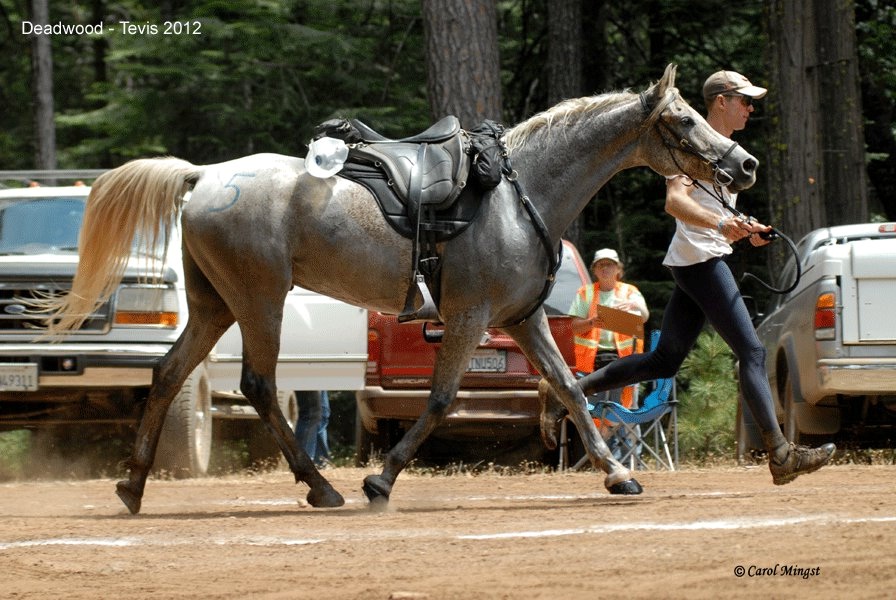
Footnote: There is some very interesting work is now emerging on how equine gut ulcers affect the equine posture and the flow on effect from this is under run heels and forward running hoof form too!
Dr. Kerry Ridgeway, leading Equine Veterinary Chiropractor has done a lot of study recently on how quickly horses will develop postural/hoof problems from gut ulcers. What is alarming is that most horses will develop ulcers at some point. It is truly frightening how quickly stressed horses will develop ulcers, sometimes just changing paddocks is enough to cause serious ulcers and just about every performance horse is suffering from ulcers.
Dr. Ridgeway's work work shows how most performance horses are subject to serious and undiagnosed ulcers which are limiting their performance, destorying their bodies and even causing serious behavoural issues.
We have so much yet to learn!
Good luck with your barefoot rehab. You will be greatly rewarded for your efforts.
Chrisann Ware EMT & UHHGM
Equethy Barefoot Educational Workshops ( Australia )
email equethy@bigpond.com

